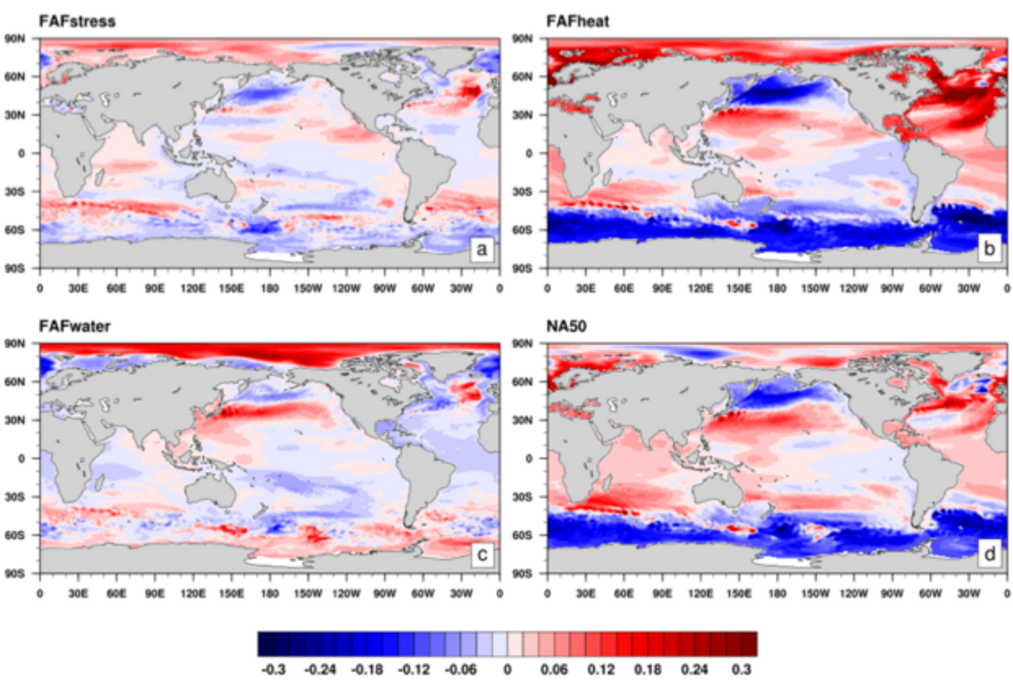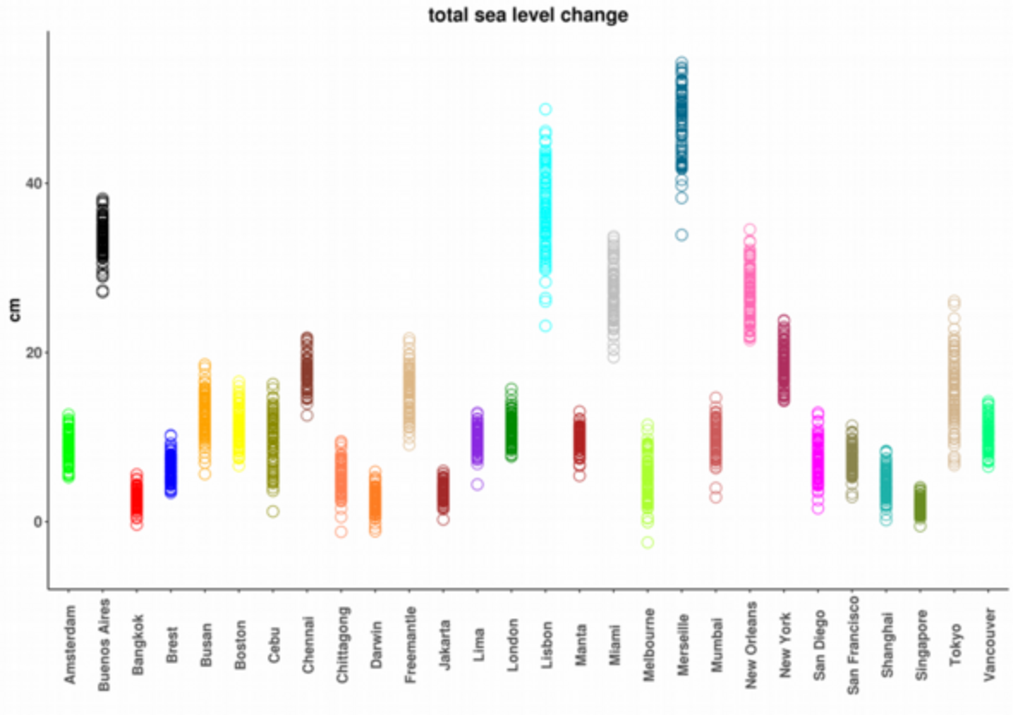DECVAR-2
Causes of Decadal to Centennial Regional Sea Level Variations (DECVAR-2)
Objectives during 2nd phase
For an improved understanding of future sea level changes on decadal to centennial time- scales in terms of natural dynamic modes versus anthropogenic influences, it is important to identify potential underlying forcing factors as well as natural dynamical contributions, including coastal dynamics. During the first phase of the SPP 1889 SeaLevel, the DECVAR project investigated processes related to the impact of various forcing mechanisms, notably heat, freshwater fluxes and wind stress, on sea level projections as well as statistical properties of natural sea level variations along coastlines. The work is part of the Coupled Model Intercomparison Project Phase 6 (CMIP6) Flux-Anomaly-Forced Model Intercomparison Project (FAFMIP) experiment, which aims to attribute CMIP5 projected sea level changes to individual forcing mechanisms.
FAFMIP was proposed through the WCRP Grand Challenge on “Sea Level Rise and Regional Impacts” and studies the response to well-defined conditions, i.e. in the FAFMIP experiments, a prescribed set of surface flux perturbations is applied to the ocean. These perturbations are obtained from the ensemble-mean changes simulated at the time of doubled CO2 by CMIP5 AOGCMs under the 1% CO2-increase-per-year scenario, so they are representative of projected anthropogenic climate change for this scenario.
DECVAR-2 will focus on future decadal and long-term regional sea level variations from basin scale down to local scale at the two SPP study regions, notably the western tropical Pacific and Indonesian through-flow region as well as the German Bight.
Questions of primary importance, which will be addressed as part of this work are:
i) What processes affect regional sea level changes in the coastal regions of the two SPP 1889 study regions over the next decades and until the end of the century;
ii) What are the statistical properties of decadal to centennial variability in the two SPP 1889 regions;
iii) What are the dynamical processes underlying anthropogenic trends and decadal to centennial variability;
iv) What is the influence of model resolution on the projections and the model’s response to forcing components in general and with respect to the two focus regions in particular.
Work programme incl. proposed research methods
The study aims at identifying and attributing the causes of future regional and local sea level changes to internal (unforced) natural climate modes and specific external forcing mechanisms, including anthropogenic forcing, as well as quantifying the anthropogenic signal from the natural variability, thus separating long-term trends from free oscillations. Such a separation is essential to more comprehensively understand long-term trends in the study regions. This will be accomplished by jointly analyzing the following three major numerical activities, aided by observations:
(1) FAFMIP forcing sensitivity experiment
(2) 100-member MPI-ESM ensemble under RCP climate-change forcing
(3) Climate projections with high-resolution models, including eddy-resolving ocean models.

The working packages of DECVAR-2
The study will be subdivided into two closely interlinked – scientifically and methodically – work packages (WP):
WP 1: FAFMIP and Multi-ensemble Analysis
In WP 1, the study will continue the FAFMIP work to separate the signature of various contributions of the anthropogenic forcing to the sea level change signal in climate projections, by analyzing sea level sensitivity to specific forcing mechanisms, including wind stress, heat flux and freshwater flux, based on coupled Atmosphere-Ocean General Circulation Model (AOGCM) runs, specifically the MPI-ESM1.2-HR setting featuring a resolution of ca. 100 km in the atmosphere and 40 km in the ocean (Fig. 1). As a unique contribution to FAFMIP, we will also perform simulations using the MPI-ESM-ER (Gutjahr et al., 2019) with an eddy-resolving ocean model.
Our research goals include:
- Analyzing the difference in the geographical patterns of sea level change due to ocean density and circulation change simulated by the models as a response to common surface flux perturbations.
- Investigating the role of improved representation of oceanic eddies for the forced changes and variability, by performing a detailed intercomparison between LR and HR runs to document the sensitivity of results to model resolution. This will offer an insight into the sensitivity of the Atlantic Meridional Overturning Circulation (AMOC) changes, which is of relevance to both regional and global sea level rise.
- Separating the passive advective component of the thermosteric and halosteric sea level rise from the dynamic response to heat and freshwater perturbations, with the usage of passive tracers so as to simulate the pathways of heat and freshwater input and identifying any non-local sea level changes.
WP-2: High-resolution analysis: Mechanism of Future Sea Level Variability
On decadal time scales, natural variations can be substantially larger than anthropogenic effects and represent the main driver for regional sea level variations in specific regions, making it difficult to attribute observed changes (e.g., Hu and Deser, 2013; Carson et al., 2015; see also Fig. 2 for instance). For regional to coastal sea level variations, unresolved dynamics and processes play a fundamental role in, e.g., communicating open-ocean variability to coastal regions, or sea level anomalies along ocean boundaries as coastal waves. Until now, both processes were not resolved in CMIP-type climate models, hindering detailed information about future sea level changes in the two SPP study regions. This situation is currently changing gradually. In particular, climate projections are now being run at high-resolution, and eddy-resolving ocean models in particular, include for the first time the dynamical processes that can lead to detailed sea level change information along coastlines.
The aim of the WP-2 is to provide improved projections of the future sea level variability and change on regional to local scale, taking into account small-scale and coastal processes and mechanisms. The outcome will provide information required to identify the range of possible sea level variations to be expected in the study regions and to separate anthropogenic climate signals from natural variability.
In WP-2, we will analyze high-resolution climate projections in terms of sea level variations and trends to identify their dynamical and statistical properties. A comparison with standard-resolution Diagnostic, Evaluation and Characterization of Klima (DECK) CMIP6 projections will allow to identify the impact of ocean dynamics, especially in the coastal vicinity of the SPP study regions. A comparison with the 100-member MPI-ESM Grand Ensemble will in turn allow to catalogue the projected changes on the statistically possible changes (as suggested by a full pdf) and test the provided ensemble spread against high-end expectations.
Our research goals include:
- Identifying the expected sea level variability and change at the SPP study regions as a function of space and time scales, i.e. interannual, decadal to centennial, to separate the forced component from natural variability in the study regions;
- Investigating model and resolution dependence of regional to local sea level projections
- Obtaining statistics from the 100-member ensemble of MPI model and detecting any associated changes as a response to climate change.
Role of the project within the SPP and Collaborations
DECVAR-2 is part of the SPP 1889 focus group on global to regional sea level variations and will also contribute sea level change information to the focus groups with respect to sea level anomalies in the western tropical Pacific and Indonesian Throughflow region as well as in the eastern North Atlantic, with a focus on the German Bight. Within the focus group on global to regional sea level variations, the project will provide global sea level simulation and projections, including knowledge about forcing mechanisms for natural and anthropogenically induced changes. As the only global sea level modeling approach, it will attribute projected changes to different forcing mechanisms and provide a global context for regional sea level variability. Answers provided will be essential to reach the overarching SPP goals in the sense that it will supply with process information affecting sea level on regional to local spatial scale that will accordingly enable projections or predictions in coastal areas.
Several other projects will benefit from results and information emerging from DECVAR-2. As an example, the SPP project OMCG (M. Horwath and J. Kusche) will provide global steric sea level estimates, which will be used here for a comparison with DECVAR-2 model results. On the other hand, we will provide the OMCG project with ocean modeling and reanalysis results required to interpret their observation-based findings. The SPP PARSL-Glac project (B. Marzeion) dealing with glaciers will be another important partner project required to estimate the freshwater input from glacier melting and its impact on regional to local sea level changes. The information provided will be essential to support of studies performed in the two selected SPP study regions as part of other focus groups, in terms of the possible range of sea level rise over the next decades and up to a century. This information will be of paramount importance for future coastal management in the study regions and will form the basis for a better-informed planning of adaptation measures. Furthermore, it will be essential in order to improve our understanding of sea level predictability in various parts of the world. This latter aspect is planned to be studied during the next funding phase.

